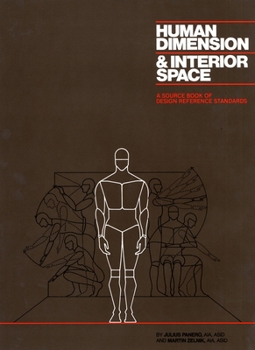Human Dimension and Interior Space: A Source Book of Design Reference Standards
Select Format
Select Condition 
Book Overview
The study of human body measurements on a comparative basis is known as anthropometrics. Its applicability to the design process is seen in the physical fit, or interface, between the human body and the various components of interior space. Human Dimension and Interior Space is the first major anthropometrically based reference book of design standards for use by all those involved with the physical planning and detailing of interiors, including interior designers, architects, furniture designers, builders, industrial designers, and students of design. The use of anthropometric data, although no substitute for good design or sound professional judgment should be viewed as one of the many tools required in the design process. This comprehensive overview of anthropometrics consists of three parts. The first part deals with the theory and application of anthropometrics and includes a special section dealing with physically disabled and elderly people. It provides the designer with the fundamentals of anthropometrics and a basic understanding of how interior design standards are established. The second part contains easy-to-read, illustrated anthropometric tables, which provide the most current data available on human body size, organized by age and percentile groupings. Also included is data relative to the range of joint motion and body sizes of children. The third part contains hundreds of dimensioned drawings, illustrating in plan and section the proper anthropometrically based relationship between user and space. The types of spaces range from residential and commercial to recreational and institutional, and all dimensions include metric conversions. In the Epilogue, the authors challenge the interior design profession, the building industry, and the furniture manufacturer to seriously explore the problem of adjustability in design. They expose the fallacy of designing to accommodate the so-called average man, who, in fact, does not exist. Using government data, including studies prepared by Dr. Howard Stoudt, Dr. Albert Damon, and Dr. Ross McFarland, formerly of the Harvard School of Public Health, and Jean Roberts of the U.S. Public Health Service, Panero and Zelnik have devised a system of interior design reference standards, easily understood through a series of charts and situation drawings. With Human Dimension and Interior Space , these standards are now accessible to all designers of interior environments.
Format:Hardcover
Language:English
ISBN:0823072711
ISBN13:9780823072712
Release Date:January 1979
Publisher:Watson-Guptill
Length:320 Pages
Weight:3.37 lbs.
Dimensions:1.2" x 9.0" x 11.9"
Customer Reviews
5 ratings
Great Quick Reference
Published by Thriftbooks.com User , 17 years ago
I honestly think this is one of the best books in my large Interior Design related library. It is extensive, yet to the point. It explains human dimension from a point you would never imagine ever existed or was in any way important. Provides very useful measurements, detailed drawings, and space planning suggestions - great resource!
Indispensible Resource
Published by Thriftbooks.com User , 17 years ago
I purchased this book over 22 years ago and loved it then! I lost my copy during a move and now am looking to repurchase it. Without a doubt, it was one of the most valuable books in my collection for designing custom homes! As an architectural designer, I highly recommend this book to any design professional or student!
It's All Inside!
Published by Thriftbooks.com User , 17 years ago
One of the best reference books to date for building ergonomic interiors.
I couldn't live without it.
Published by Thriftbooks.com User , 22 years ago
As a licensed Interior Designer I refer to this book frequently. To determine the space required for any activity from opening a file drawer to dining, watching a movie or simply removing an object from a shelf this book gives it to you straight with no fluff. It contains simple but indispensible scientific data for the 95th percentile and beyond. Whether you are a student or a professional, in Interior Design, Architecture or Industrial Design I highly recommend Human Dimension and Interior Space.
This book serves as a linchpin in designing any interior!
Published by Thriftbooks.com User , 26 years ago
Human Dimension & Interior Space provides information about interior space requirements and human dimensions that are indispensable to the beginning design student or the practicing professional. Its drawings and charts are clear, easy to understand and even easier to apply. It should be part of every design professional's library or student's required reading list. It is also refreshing to note that this book has integrated barrier free design/accessibility issues into each space type that is covered, and not made it a separate issue.






